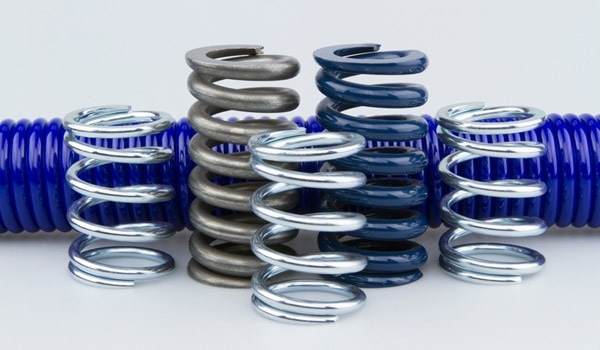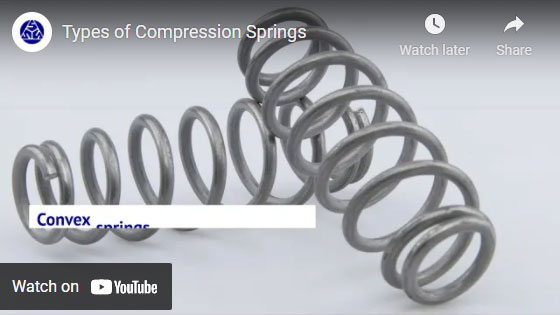Compression springs are coil springs that hold mechanical energy in their compressed states. When these springs experience a compression load, they compress and become shorter, capturing and storing significant potential force. Once the load is diminished or removed, the stored energy forces the springs back to their original shapes and lengths.
The following page provides a more detailed explanation of compression springs, as well as the types available and their advantages.
What Are Compression Springs?
Compression springs are helical—i.e., spiral-like—springs. When force isn’t applied to them, they demonstrate an open-coiled design. However, as pressure presses down along the axis of the spring, the coils push tighter against each other. This effect shortens the length of the spring and stores energy. Once the pressure ceases, the stored energy returns the spring to its original height.
Manufacturers build compression springs into a variety of products, such as:
- Automobile suspensions
- Couches
- Mattresses
- Medical devices
- Pacemakers
- Pens
- Hydraulic
- Medical
- Lawn equipment
- Fire arms
- Marine industry
- Underwater oil rig piping
- Watches
Compression springs offer flexibility and strength, both of which are essential characteristics in industrial applications, including those found in the following industries:
- Automotive
- Electronics
- Mattress manufacturing
- Watchmaking
Types of Compression Springs
Compression springs come in a wide range of shapes and sizes, each of which significantly impacts the force and tension an individual spring provides. Different kinds also contain and deliver power through various forms.
The types of compression springs available include:
Convex springs
Convex springs (i.e., barrel-shaped springs) have coils with larger diameters in the middle of the spring and coils with smaller diameters on both ends. This design allows the coils to fit within each other when the spring is compressed. Manufacturers use convex springs in applications that require more stability and resistance to surging as the springs decompress. Most applications that use them are in the automotive, furniture, and toy industries.
Concave springs
Concave springs (i.e., hourglass springs) have narrower coils in the middle of the spring than on either end. The symmetrical shape helps ensure the springs stay centered over a particular point.
Conical springs
Conical springs (i.e., tapered springs) are shaped like cones. One end has a larger diameter than the other, and the coils throughout the spring provide a gradual taper or change in size. Some conical springs have enough change in diameter from coil to coil so that each coil fits into the previous one.
Straight coil springs
In these springs, every coil has the same diameter. Straight coils are some of the most common springs in use.
Variable pitch springs
Variable pitch springs have different distances between each coil up and down the length of the spring.
Volute springs
These springs are cone-shaped. However, instead of having wire coils, the coils are formed from a curled sheet of metal or other material.
Contact Southern Spring & Stamping, Inc. for Your Compression Spring Needs
Compression springs find use in a wide range of industrial applications due to their ability to hold and release energy without complex parts or mechanisms.
At Southern Spring & Stamping, Inc., we are a leading provider of standard and custom compression springs. Equipped with over 60 years of experience in spring and wire form design and state-of-the-art machinery, our team has the skills, knowledge, and tools to offer a variety of spring options. Our spring manufacturing capabilities include:
- Shape: barrel, concave, conical, and variable pitch
- Wire size: 0.006 inches to 0.472 inches
- Material: aluminum, brass, copper, nickel alloys, steel and steel alloys, and titanium
- Finish: anodizing, electropolishing, galvanizing, painting, passivating, and more
Our manufacturing facility is ISO 9001 certified, so you can trust in the quality of our compression, extension, and specialty springs.
To learn more about our spring and wire form capabilities, visit our springs and wire forms page or contact our team today. If you’re looking for a partner for your next spring order, request a quote.

